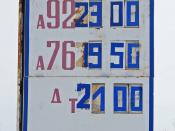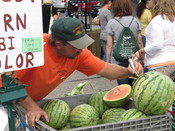Milk Prices The milk prices are one of the biggest problem farmers face today. The milk prices are so low that a lot of farms have to go out of business because they can't pay their bills. It is hard to think that the price of milk that the farmers get is the same now as it was in the 70's. Even though the price of milk in the store has increased quite a lot. The price of everything else to run a farm has also increased like grain, hay, and equipment repair and purchases. Now the government has come up with a plan that will take over for the old New England milk contract to help to farmers with the low milk prices. This program called Milk Income Loss Contract (MILC); it is suppose to give more money to the farmer. I am going to find out what the program is all about and I am also going to talk with some farmers to see if it actually does help them with the low milk price problem.
I am going to find out what some people think is the reason why the price is down and how farmers should feed their cows when the milk price is down.
Milk Income Loss Contract is a program that helps farmer with the low milk prices (www.fsa.usda.gov). The only problem with this program is that it only pays the farm the money if the farmer doesn't plant any corn on land that will erode easily (Tom Bowdrey). So really this program does not help the farms in the northeast very much because all the land up here is hilly and on a slope. If you do get into the program they will pay you $1.43 per cwt. on top of what you get in your check, but you will only get paid up to 2,400,000lbs of milk so if you make more than that you wont get paid for it (www.fsa.usda.gov). So it really doesn't amount to anything.
Personally I don't like the new program that the government has put out because I was talking to my uncle, Peter Graves, and he says that our farm doesn't get a dime because we have corn planted on land that is on a slope so it erodes easily. That doesn't make any sense because I would think that if the government was going to make a program to help the farmers that they would make it so it would help all the farmers not just the ones that have their farms on flat land. I think if the government is going to be involved they should have to make a program that can help all farmers no matter where there farm is located. Sharleen Bowdrey said that the milk companies would rather have a few big farms that they could go to than a bunch of little farms. So that may have affected the way the government made that program because all the little farms are normally in the hills so with out the help of the government they might go out of business and the milk companies would have an easier time getting the milk. But, I wouldn't think I government would do that.
I talk to some farmers about the new government program to see how it has helped them and what they thought the government should be doing to help the farmers with the low milk prices. First I talked to Tom Sawyer a local farmer in my town. He said that he doesn't like any government programs, because he thinks that the milk prices should be left to the free enterprise. I asked him what he thought the government should do to help the farmers with the low milk prices, he said that the government should get out of the milk pricing program all together. He thinks that the government programs have too many strings attached and he also says that the programs are there to help people stay in business. His farm doesn't sign up for the programs because they feel that a farm should be able to survive with out the governments help. Then I asked Tom if he likes the old milk compact better then the new MILC program and he said it was better because it took money from the consumer not the taxpayer.
Another farmer I talk to in my town was Tom Bowdrey. When I asked him the question about the new government program he also said that he doesn't like it because he liked the milk compacted better. He said that the compact brought the money from the consumer and not the government. Tom also said that with this government program we would not see a rebound in the milk price until the farm bill is over. He also thought that the government should get out of the milk-pricing program because he said that they don't help.
I also talked with my local veterinarian Dr. Shaw and he said that the government will probably always be involved with the milk pricing and farms will never know when the milk price is going to be up or down. So he thinks that every farm should have another source of income. He said that farms with a couple sources of income will not be as shaken up when the milk prices are down and he thinks that the farms that rely only on the milk check are going to be in series trouble.
I asked all the people I interviewed what kind of advice they would give a young farmer getting started. They all basically had the same answers which was don't get to far indebt because the price of milk isn't going up too fast and you won't be able to pay your bills, it is a hard industry to get into so if you do you will have to be flexible and you are going to have to want to work hard for not very much money. They also all said that you would have to find a way to diversify because the way the milk prices are going the milk check might not be able to pay for all the bills. Some of the things they said would be good to do was to try to raise extra heifers to sell. They said that farmers always want more cows they are currently milking, so people will always want to buy heifers. The need for more cows will also increase the likelihood that extra hay can always be sold. Farmers should also produce and sell your own products. Like pasteurizing your own milk, making yogurt, cheese or ice cream. Tom Sawyer said that if you were going to start a farm for your self, don't start one in New England. It was hard to find land in New England to farm and it is cheaper in farm out west. Tom also said jokingly that you have to milk jerseys and to make sure that you don't have a girl friend or marry any one with horses because they are a big waste of money. Tom knows this from experience! There is a farmer in Vermont named Emily Noris that is also trying to get the UVM Extension to help to try to deal with the low milk prices. She feels that they are partly the reason that the farmers are in to this situation. She says that the extension has been part of a group of teachers motivating farmers to improve animal care and reduce mortality, and to get more efficient. This makes more animals that can make more milk. I do agree with her because that is what the extension is suppose to be doing, but the more milk that farmers produce the lower the milk price will go. So more milk is not always a good thing.
The reason why the milk prices are down so much according to Bob Wellington, who writes in the Weekly Market Bulletin, is that there is less cheese being used in pizza. He also feels that since Sept. 11 2001, it has triggered changes in consumer behavior, that have had the effect of stalling the demand on farm milk which has consequently driven the price of milk down. The real reason he explains is the sudden use of less cheese on pizza. He says that consumers still eat lots of pizza but they are eating a lot more frozen pizza instead of going to the pizza parlors. A slice of pizza from a decent pizza parlor has up to 6 to 7 ounces of cheese while a slice of frozen pizza will be likely to only have 3 to 4 ounces of cheese. And even the better pizza restaurants have been gradually reducing cheese amounts because of price volatility in recent years. A little less cheese going into pizza adds up to big impacts on manufacturers, and, in turn, on farm milk prices. Another thought in why the milk prices are down so bad comes from National Milk's Chris Galen. He thinks that the USDA's butter powder tilt will have negative effects on dairy producers. He says that they have been working to prevent the tilt ever since the time USDA did this a year and a half ago. The "shocking development" as Galen put it, will cost the dairy producers nearly $900 million next year, " and we are very disappointed by what USDA did, not just the timing but the overall impact." He predicted that the average All-Milk price will lose about 50 cents per cwt. because of it (Lee Mielke).
Mary Beth de Ondarza, a writer for Hoard's Dairymen, talks about feeding cows in times of low milk prices. "When dairy producers complain to me about the low milk prices, I look for a way to improve their feeding efficiency, since efficiency and profitability are closely related." Here are some of the things she look at to help the farmers. "First the forage intake is critical. The more forages you can get into your cows, the more money you will have in your pockets" she says which is very true. She goes on saying that high producing cows with well functioning rumens are limited in forage intake by the bulkiness of the forage that fills the rumen. High fiber forages, epically those with a slow rate of digestion, pass out of the rumen slowly. The longer the particles sit in the rumen, the longer the cow seems full, and intake is reduced. So she says to feed as much NDF (Neutral Detergent Fiber) as the cow can eat, which is about 1% if the cows body weight she can eat in NDF. To make sure that your feed has enough NDF, begin the harvest season with the intention to do everything in your power to get the forage cut on a timely manner so that NDF digestibility will be high. She also says that the more little meals you can give a cow the better the cow can digest the food. It will also keep the feed in front of the cow fresh so that the cow will want to eat the food that is in front of her. She also explains that your heifers are very important. Even with the low milk price you can't cheat your heifers, they are the future of the herd. Your heifer needs to freshen at 22 the 24 months and be at least 1300 pounds of muscle and bone after dropping the calf. To do this calves need to get off at a good start and be feed well. On the same milking ration, a 1200lbs heifer will eat 1 pound less forages NDF and 4 pounds less total dry matter than a 1300lbs heifer. Which translates into 10 pounds less milk a day. So in feeding your heifers right you can get more milk out of them, which is also more money in your pocket.
In conclusion to all of this I have found out that the farmers that I interviewed didn't like the government program MILC and really didn't like any program that had to do with the government. I feel that they represent a good portion of the farmers in the state. I somewhat agree with their responses, but I feel the government will always be apart in the milk pricing so I feel that they should just do a better job in finding a solution with this big problem. I also feel that farmer should now how to feed their cows when the milk prices are down. If they can feed the cows somewhat cheaper and make almost as much milk, they wont have as much of a problem paying for feed. It is also hard for me to believe that the farmer gets paid so little for the milk that they produce and the middle man gets to make all the money. Alls they have to do is pasteurize the milk or make it in to cheese. The farmer does all the work and gets nothing to show for it. If I was in a position of power in the government I would figure out a way to evenly distribute the money because the farmers are getting down right screwed.
Milk Prices Andy Westover Andy Westover Itro. Dairy Management References ÷ Bowdrey, Tom, Wentworth Rd, Walpole NH ÷ Bowdrey, Sharleen, Wentworth Rd, Walpole NH ÷ De Ondarza, Mary Beth, Fedding cows in times of low milk prices, Hoard's Dairyman, July 2002, page 482 ÷ Graves, Peter, County Rd Walpole, NH ÷ http://www.fsa.usda.gov/dafp/psd/MILC.htm 11/26/2002 ÷ Mielke, Lee, Dairyline, country Folks, December 2, 2002, page 10 section A ÷ Norris, Emily, E-mail, October 26, 2002 ÷ Sawyer, Tom, Wentworth Rd, Walpole NH ÷ Shaw, Dr. Chuck, Old Keene Rd, Walpole NH Wellington, Bob, Less Cheese in Pizza, Less Money for Farmers, Weekly Market Bulletin, Vol 81 Page








